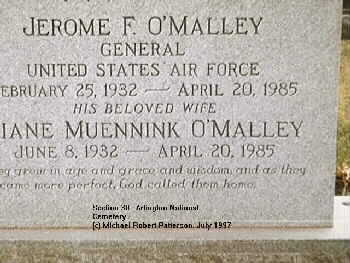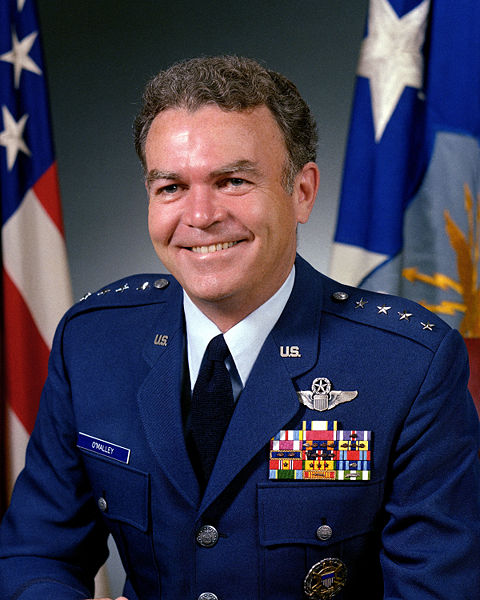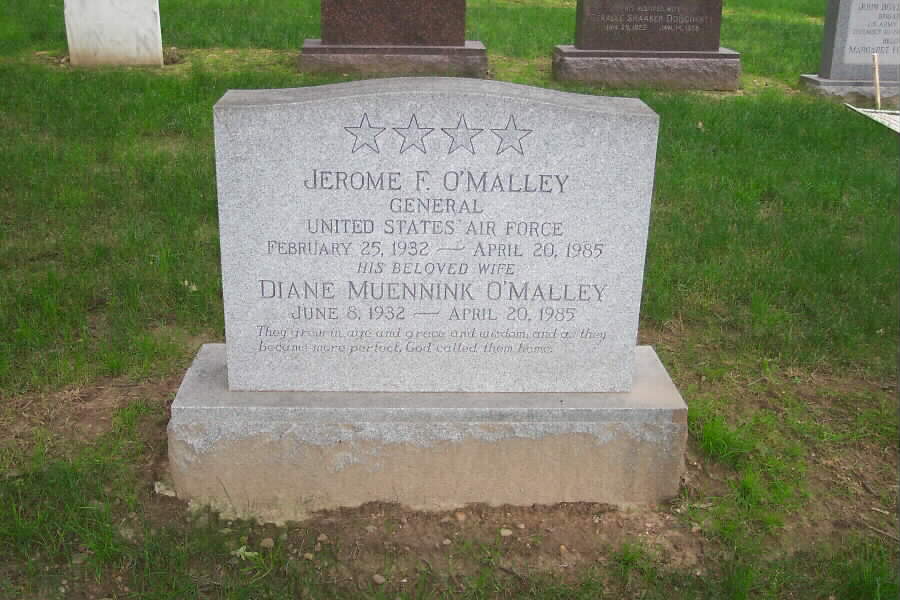From contemporary news reports:”Funeral services for General and Mrs. Jerome F. O’Malley, who died in an aircraft accident on April 20, 1985 at the Scranton-Wilkes-Barre, Pennsylvania, airport, will be held at the Fort Myer Chapel on April 25, 1985. Graveside services will follow in Arlington National Cemetery.
“General O’Malley was born on February 25, 1932 at Carbondale, Pennsylvania, and graduted from West Point in 1953 with B.S. degree in Military Science and a commission as a Second Lieutenant in the United States Air Force. He completed Air Command and Staff College and concurrently earned a Masters Degree in Business Administration from George Washington University in Washington, D.C. He also graduated from the Naval War College. After receiving his pilot’s wings in August 1954 at Bryan Air Force Base, Texas, he received jet training in F-86 Sabrejets at Perrin Air Force Base, Texas. In Jnauary 1955, he was assigned as an Air Training Officer at the United States Air Force Academy, then located at Lowry Air Force Base, Colorado. He attended B-47 transition training at McConnell AFB, Kansas, from December 1957 to February 1958, and was then assigned as a B-47 pilot with the 529th Bombardment Squadron at Plattsburgh AFB, New York. From June 1960 to August 1964, he served as an Aide to General Hunter Harris, 8th Air Force Commander at Westover AFB, Massachusetts, and then Vice Commander in Chief, Strategic Air Command at Offutt AFB, Nebraska. After graduating with distinction from the Air Command and Staff College in June 1965, he served as a pilot with the 9th Strategic Recommaissance Wing, Beale AFB, California. While there he flew the first operational mission of the SR-71 (Blackbird) the free world’s most advanced strategic reconnaissance aircraft.
In June 1969 he entered the Naval War College. From 1970 to April 1971, he was Director of Operations for the 67th Tactical Reconnaissance Wing, Mountain Home AFB, Idaho, and flew RF-4Cs. Then he left for Southeast Asia and served as Vice Commander and later Commander of the 460th Tactical Reconnaissance Wing at Tan Son Nhut Air Base, Republic of Vietnam. From September 1971 he was assigned as Vice Commander of the 432nd Tactical Reconnaissance Wing, Udorn Royal Thai AFB, Thailand. He flew 116 combat missions in F-4Ds and RF-4Cs. He comanded the 9th Strategic Reconnaissance Wing at Beale AFB from May 1972 to May 1973. Then was named commander of the 22nd Bombardment Wing, March AFB, California and later served as Chief of Staff for the 15th Air Force, also located at March AFB. He was then assigned as Assistant Deputy Chief of Staff for Plans at the Strategic Air Command Headquarters, July 1974 to June 1975, when he was named Deputy Chief of Staff for Operations and Pland. In January 1977, he moved to Washington, D.C. for duty as Vice Director of Operations, Operations Directorate, Joint Staff. He served as Assistant Deputy Chief of Staff, Operations, Plans and Readiness at Headquarters, USAF, from May 1979 to August 1980. He then became Deputy Chief of Staff for Plans and Operations.
Appointed Vice Chief of Staff of the U.S. Air Force in June 1982 and in October 1983 was named Commander in Chief of the Pacific Air Forces, Hickam AFB, Hawaii. In September 1984 he assumed duties as Commander of the Tactical Air Command, Langley AFB, Virginia, the position that he was filling at the time of his death.
He was a Command Pilot with more than 5,000 flying hours. His decorations and medals included the Distinguished Service Medal with oak leaf cluster, Defense Superior Service Medal, Legion of Merit, Distinguished Flying Cross with oak leaf cluster, Meritorious Service Medal, Air Medal with nine oak leaf clusters, the Air Force Commendation Medal with 3 oak leaf clusters, the Presidential Unit Citation Emblem with two oak leaf clusters, Repblic of Korea Order of National Security Merit, Republic of Vietnam Air Service Medal (Honor Class) and the Republic of Vietnam Gallantry Cross with palm.
He was promoted to full General, June 1, 1982.
He is survived by two sons, James Francis O’Malley and John Thomas O’Malley; and two daughters, Margaret Anne O’Malley Neal and Sharon Kay O’Malley.”
ACCIDENT INFORMATION:Witnesses said that the aircraft, a twin-engine CT-39 Sabreliner,overshot a runway at the Wilkes-Barre Scranton International Airport, dropped from a 175-foot cliff and burst into flames. The crash also killed his wife Diane and three Air Force crew members on board. He had been considered a likely candidate to become Air Force Chief of Staff. He had broad contacts on Capitol Hill, had testified frequently at Congressional hearings and had given private briefings to several leading Members of Congress. An Air Force spokesperson said that the Air Force Investigating Team was at the scene and that a report would be issued in 30 to 60 days. It was not immediately determined who was at the controls of the military aircraft when it crashed. The Lackawanna County Coroner said that he was advised by the Air Force that General O’Malley was listed as the co-pilot for the flight. There was a strong possibility that the General was in the cockpit at the time of the crash.
The Department of Defense said that the Air Force acquired numberous T-39s in the 1950s and 1960s for use as a basic utility and training aircraft. The craft seats up to seven people. There was no flight recorder on the plane, which had been flown from Langley Air Force Base in Virginia. The General was scheduled to speak yesterday as a Boy Scout of America banquet in Scranton in honor of U.S. Representative Joseph M. McDade of Pennsylvania, a longtime friend and the ranking Republican on the House Appropriations and Military sub-committees.”
The General and his wife, Diane Muennik O’Malley (June 8, 1932-April 20, 1985), were buried in section 11 of Arlington National Cemetery, beneath a private memorial which reads:”They grew in age and grace and wisdom:
And as they became more perfect, God called them home.”
COURTESY OF THE UNITED STATES AIR FORCEGENERAL JEROME F. O’MALLEY
Died on active duty April 21, 1985
General Jerome F. O’Malley was commander of Tactical Air Command, with headquarters at Langley Air Force Base, Va. His command comprises more than 113,000 military and civilian personnel, stationed at 18 major Tactical Air Command installations and other units in the United States, Panama, Okinawa and Iceland. Tactical Air Command is the gaining organization for 64,000 Air National Guard and Air Force Reserve personnel throughout the United States.
General O’Malley was born in Carbondale, Pennsylvania, and graduated from St. Rose Parochial School in 1949. He graduated from the U.S. Military Academy, West Point, N.Y., in 1953 with a bachelor of science degree in military science and a commission as a second lieutenant in the U.S. Air Force. General O’Malley completed the Air Command and Staff College at Maxwell Air Force Base, Ala., and concurrently earned a master’s degree in business administration from The George Washington University, Washington, D.C., in 1965, and graduated from the Naval War College, Newport, Rhode Island, in 1970.
After receiving his pilot wings in August 1954 at Bryan Air Force Base, Texas, General O’Malley received jet training in F-86 Sabrejets at Perrin Air Force Base, Texas.
In January 1955 he was assigned as an air training officer at the U.S. Air Force Academy, then located at Lowry Air Force Base, Colorado. He attended B-47 transition training at McConnell Air Force Base, Kan., from December 1957 to February 1958, and was then assigned as a B-47 pilot with the 529th Bombardment Squadron at Plattsburgh Air Force Base, New York. From June 1960 to August 1964, General O’Malley served as an aide to General Hunter Harris, who was 8th Air Force commander at Westover Air Force Base, Massachusetts, and then vice commander in chief, Strategic Air Command, Offutt Air Force Base, Nebraska.
Following graduation with distinction from the Air Command and Staff College in June 1965, General O’Malley served as a pilot with the 9th Strategic Reconnaissance Wing, Beale Air Force Base, Calif. While there he flew the first operational mission of the SR-71, the free world’s most advanced strategic reconnaissance aircraft. In July 1969 he entered the Naval War College.
From July 1970 to April 1971, he was director of operations for the 67th Tactical Reconnaissance Wing, Mountain Home Air Force Base, Idaho, and flew RF-4Cs. General O’Malley then left for Southeast Asia and served as vice commander and later commander of the 460th Tactical Reconnaissance Wing at Tan Son Nhut Air Base, Republic of Vietnam. In September 1971 he was assigned as vice commander of the 432nd Tactical Reconnaissance Wing, Udorn Royal Thai Air Force Base, Thailand. He flew 116 combat missions in F-4D’s and RF-4Cs.
He commanded the 9th Strategic Reconnaissance Wing at Beale Air Force Base from May 1972 to May 1973. He was then named commander of the 22nd Bombardment Wing, March Air Force Base, Calif., and later served as chief of staff for 15th Air Force, also located at March Air Force Base. He was then assigned as assistant deputy chief of staff for plans at SAC headquarters, Offutt Air Force Base, from July 1974 to June 1975, when he was named deputy chief of staff for operations plans.
In January 1977 the general moved to Washington, D.C., for duty as vice director for operations, Operations Directorate, Joint Staff, Organization of the Joint Chiefs of Staff. General O’Malley served as assistant deputy chief of staff, operations, plans and readiness at U.S. Air Force headquarters, from May 1979 to August 1980, when he became deputy chief of staff for plans and operations. The general was appointed vice chief of staff of the U.S. Air Force in June 1982 and in October 1983 was named commander in chief of the Pacific Air Forces, Hickam Air Force Base, Hawaii. He assumed his present command in September 1984.
General O’Malley is a command pilot with more than 5,000 flying hours. His military decorations and awards include the Distinguished Service Medal with oak leaf cluster, Defense Superior Service Medal, Legion of Merit, Distinguished Flying Cross with oak leaf cluster, Meritorious Service Medal, Air Medal with nine oak leaf clusters, Air Force Commendation Medal with three oak leaf clusters, Presidential Unit Citation Emblem with two oak leaf clusters, Air Force Outstanding Unit Award Ribbon with “V” device and three oak leaf clusters, Republic of Korea Order of National Security Merit, Republic of Vietnam Air Service Medal Honor Class and Republic of Vietnam Gallantry Cross with palm.
He was promoted to general June 1, 1982, with same date of rank.

Michael Robert Patterson was born in Arlington and is the son of a former officer of the US Army. So it was no wonder that sooner or later his interests drew him to American history and especially to American military history. Many of his articles can be found on renowned portals like the New York Times, Washingtonpost or Wikipedia.
Reviewed by: Michael Howard


